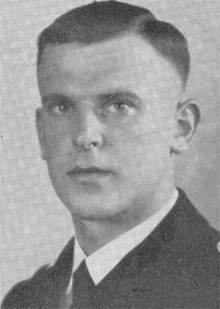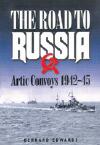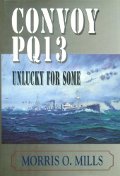PQ-13
Iceland - Russia (Arctic Ocean)28 Mar 1942 - 1 Apr 1942
| The Convoy | 19 ships |
| First sighting | On 28 Mar 1942 by U-209 |
| Escorts | When leaving Loch Ewe on 10 March: Escort Group 7, led by Polish destroyer ORP Blyskawica (H 34) (Kmdr ppor. W. Francki, ORP) with Norwegian destroyer HNoMS Newport (G 54) and British destroyers HMS Lamerton (L 88) (LtCdr C.R. Purse, DSC, RN), HMS Saladin (H 54) (LtCdr G.V. Legassick, RNR) and HMS Sardonyx (H 26) (LtCdr R.B.S. Tennant, RN). When leaving Reykjavik on 20 March: 21st A/S Group with British armed trawlers HMS Bute (T 168) (A/Ty/Lt A.F.W. Boumphrey, RNVR), HMS Celia (T 134) and HMS Whitethorn (T 127) (Ty/Lt W.J. Griffiths, RNR) until 23 March, when relieved by the Close Escort, led by British destroyer HMS Fury (H 76) (LtCdr C.H. Campbell, DSC, RN) with British destroyer HMS Eclipse (H 08) (LtCdr E. Mack, DSC, RN) and British cruiser HMS Trinidad (46) (Capt L.S. Saunders, RN). A strong Distant Cover Force (VAdm A.T.B. Curteis, CBE, RN) was stationed northeast of Iceland with British battleships HMS Duke of York (17) and HMS King George V (41), British battlecruiser HMS Renown (72), British aircraft carrier HMS Victorious (38), British cruisers HMS Edinburgh (16) and HMS Kent (54) and British destroyers HMS Ashanti (F 51), HMS Bedouin (F 67), HMS Echo (H 23), HMS Escapade (H 17), HMS Eskimo (F 75), HMS Faulknor (H 62), HMS Foresight (H 68), HMS Icarus (D 03), HMS Inglefield (D 02), HMS Marne (G 35), HMS Onslow (G 17), HMS Punjabi (F 21), HMS Tartar (F 43) and British escort destroyers HMS Ledbury (L 90), HMS Middleton (L 74) and HMS Wheatland (L 122) in case the German battleship Tirpitz and the heavy cruisers Admiral Scheer and Admiral Hipper operated against the convoy from Norway. For the same reason the Soviet submarines K-21, K-22, ShCh-404 and ShCh-421 were positioned on the southern flank of the planned route. |
U-boats | U-593 (Kelbling) Wolfpack Ziethen: U-209 * (Brodda), U-376 * (Marks) and U-378 (Hoschatt) Wolfpack Eiswolf: U-435 * (Strelow), U-454 (Hackländer) and U-589 * (Horrer), later joined by U-456 * (Teichert) and U-585 (Lohse) ++ * U-boats that fired torpedo or used the deck gun |
The battle | On 10 Mar, 1942, convoy PQ-13 left Loch Ewe with 19 ships to Iceland. At 21.12 hours on 11 March, U-593 on her transit from Germany to France unexpectedly encountered the convoy but was immediately engaged by HMS Lamerton and HNoMS Newport and kept submerged. The U-boat tried to regain contact but gave up after being bombed by a Hudson aircraft the next day. The convoy ran into heavy weather the next night and hove to for 24 hours until reforming at dawn on 14 March. Several ships and escorts suffered storm damage and HNoMS Newport had to leave because she was low on fuel, but all ships safely arrived at Reykjavik on 16 March. There three small merchants on transfer to Iceland left the convoy and were replaced by a fleet oiler and two ships that had missed sailing with an earlier PQ convoy. On 18 March, PQ-13 sailed from Reykjavik but was ordered to return to port when they were in the Denmark Strait due to a false report that Tirpitz was at sea. On 20 March, the convoy sailed again under escort by three armed trawlers which were released after three days by the close escort of one cruiser and two destroyers and joining from Seydisfjordur: two armed trawlers, three minesweeping whalers on transit to North Russia and Force Q (fleet oiler Oligarch and HMS Lamerton). During the night of 24/25 March, the ships were hit by a northeasterly gale and had to heave to in the Norwegian Sea for two days, scattering the ships of the convoy over a distance of 150 nautical miles. During the first night of the storm the ships iced up, which made the whalers top heavy and forced them to clear their superstructure of ice due to the danger of capsizing. On 9 March, this had already happened to HMS Shera (FY 1724) in convoy PQ-12 and is also the most likely cause of loss for HMS Sulla, which was reported missing after being last seen in the evening on 24 March. The bad weather prevented refueling of the escorts by the fleet oilers, therefore Force Q returned to Iceland, safely arriving on 29 March. The scattered ships continued eastwards, some of them alone and others formed small groups. Because the convoy commodore’s (Cdr D.A. Casey, CBE, DSC, RNR) ship River Afton had lost contact with all other ships and continued independently a new convoy was formed by the vice commodore in Induna which consisted of six merchants escorted by HMS Silja. The poor endurance of the whalers caused the first problem as HMS Fury had to locate and refuel HMS Sumba at 72°16N/13°07E and then ordered HMS Paynter to stay with the whaler. On the morning of 27 March, three ships from convoy PQ-13 were sighted by a German Bv138 flying boat (2./KüFlGr 406) south of Bear Island and U-209, U-376, U-378 and U-655 of wolfpack Ziethen were ordered by Gruppe Nord to form a patrol line off the North Cape, not knowing that U-655 had been lost during combat against convoy QP-9 on 24 March. At 07.00 hours on 28 March, U-209 made the first contact when they sighted the Polish steam merchant Tobruk (7048 GRT) escorted by HMS Blackfly at 73°20N/23°50E. The encounter was inconclusive, as the U-boat missed the trawler with a stern torpedo and the depth charges dropped on her caused no damage. Soon thereafter the ships dropped out of sight in a scurry of snow. During the morning the weather improved a bit and this led to several attacks by Ju88 bombers (III./KG 30) during the afternoon which sank two stragglers from the convoy, the Panamanian steam merchant Raceland (4807 GRT) at 72°40N/20°20E and the British steam merchant Empire Ranger (7007 GRT) at 72°13N/32°10E. The main convoy group was also attacked by an aircraft that damaged the Panamanian steam merchant Ballot (6131 GRT) and missed the Honduran steam merchant Mana (3283 GRT). Also missed were HMS Paynter and HMS Sumba, the straggler Harpalion (5486 GRT) and HMS Trinidad which had to evade several bombs for about an hour until escaping in a snow squall. At 16.00 hours on 28 March, the 8th Destroyer Flotilla (KptzS Pönitz), led by Z-26 (KKpt G. von Berger) with Z-24 (KKpt M. Saltzwedel) and Z-25 (KKpt H. Peters) left Kirkenes to intercept convoy PQ-13 and a few hours later were sighted and reported by K-21 (Cpt3cl N.A. Lunin) which was unable to attack due to low visibility. However, the Eastern Local Escort with three destroyers and four minesweepers was already underway from Murmansk and joined the main convoy group the next morning. Admiral Nordmeer ordered U-435, U-454 and U-589 of wolfpack Eiswolf to form a patrol line off Kola Inlet and sent U-456 and U-585 as reinforcements from Kirkenes. The latter was unsuccessfully attacked by the Soviet submarine M-171 (CptLt V.G. Starikov) in the Varangerfjord, and reported its position a last time at 14.58 hours on 29 March and went missing thereafter, possibly hitting one of many mines that drifted from the German defensive minefield "Bantos-A" laid only a few days earlier not far from the last reported position of U-585. On 29 March, command over the U-boats of wolfpack Ziethen was transferred from Gruppe Nord to Admiral Nordmeer, who ordered all U-boats (still including U-655) to form a new patrol line north of the Rybachiy Peninsula. On the evening of 28 March, HMS Blackfly was ordered by the SoE to search for survivors from Empire Ranger and was lucky not to encounter the German destroyers which located the lifeboats first and took the 61 survivors as prisoner aboard Z-24. HMS Harrier and HMS Oribi also searched for the survivors until the latter located the abandoned lifeboats the next morning. In the early morning hours of 29 March, Z-26 located the Panamanian steam merchant Bateau (4687 GRT), opened fire and sank the straggler with a torpedo. Z-25 immediately went to the sinking position to rescue survivors, but could only rescue 7 survivors from the freezing cold water. At 03.50 hours on 29 March, U-376 spotted and reported the main group of convoy PQ-13 and while heading for them the German destroyers were located by the radar of HMS Trinidad in bad visibility due to snow squalls at 72°21N/33°32E at 09.43 hours. She immediately opened fire at the leading destroyer Z-26 when the ship was spotted a few minutes later at a distance of about 3500 meters and scored several hits. The cruiser then targeted Z-24 but did not hit her as she had to evade a spread of seven torpedoes fired by this destroyer. HMS Fury following astern of the cruiser could not engage the enemy. Due to the maneuvers the ships lost contact with each other until HMS Trinidad located the fleeing Z-26 and put three of her four gun turrets out of action while the cruiser had only been slightly damaged during the whole action by two or three hits. At 10.24 hours, the cruiser then tried to sink the destroyer with a torpedo which malfunctioned and became a circle runner. It struck HMS Trinidad underneath the bridge, killed 31 crew members and flooded the forward boiler room, forcing the ship to break off the combat. At 10.32 hours, the lone HMS Eclipse located the badly damaged Z-26 and began to chase her, scoring at least six hits until the enemy stopped. At 11.20 hours, HMS Eclipse was attacked by the two other German destroyers and retired after being damaged by three hits that injured several crew members two of which later died of their wounds. Attracted by the gunfire, HMS Oribi and Sokrushitelny joined the action and the latter fired six salvos at a German destroyer, claiming one hit until losing contact in a snow squall. U-376 had observed the gunfire but only once sighted a destroyer which proved to be German. After the battle, the U-boat sighted the German destroyers picking up survivors from the sinking Z-26 and was ordered to participate in the rescue operation. 240 crew members were lost in the sinking, most of the men died in the freezing cold water and while Z-24 and Z-25 rescued 96 men (including the flotilla commander and the commander of Z-26), only eight were still alive when rescued by U-376 and three of them died of exposure during the next few hours and were buried at sea. In the meantime, most ships of the convoy headed northeast to evade further air attacks and the German destroyers until reaching thick ice where Induna and HMS Silja were actually trapped by the pack ice for some hours while the remaining ships of their group continued eastwards. Eventually they worked themselves free, but the whaler was out of fuel and had to be taken in tow by the freighter. At 11.10 hours, HMS Gossamer and HMS Hussar forced U-209 to dive and carried out seven unsuccessful depth charge attacks until HMS Hussar had to leave to escort the damaged HMS Trinidad, which at that time was only escorted by HMS Oribi and HMS Fury. The latter unsuccessfully attacked U-378 with three depth charges at 14.15 hours. The escort of the damaged cruiser was soon reinforced by HMS Harrier while HMS Hussar and HMS Speedwell failed to find her. On the evening on 29 March, the tow line to HMS Silja parted and Induna searched for the whaler in vain during a snow storm and then continued alone. Some hours later the ship was spotted by U-209 and missed with a spread of two torpedoes at 05.52 hours on 30 March. The U-boat afterwards tried to overtake the Induna again, but the freighter was then torpedoed and sunk by U-376. Around the same time, U-456 spotted some of the five ships which had been in the group formed by the vice commodore and led U-435 and U-454 to them, the latter being chased away by HMS Gossamer which then left to assist Induna but failed to find her. Between 10.35 and 10.45 hours, U-456 missed Mana with a spread of three torpedoes and hit Effingham with one torpedo, but missed the damaged ship with its stern torpedo and lost contact while reloading the torpedo tubes. About two hours later, the abandoned Effingham exploded and sank after being torpedoed by U-435. On the afternoon of 30 March, HMS Oribi and HMS Harrier arrived with HMS Trinidad, HMS Eclipse and HMS Fury in Murmansk but immediately left again to patrol off Kola Inlet, soon being joined by HMS Speedwell. The group spotted the drifting HMS Silja, which was taken in tow by HMS Harrier and escorted to Polyarnoe by HMS Speedwell while HMS Oribi searched in vain for the straggler River Afton which reported that she was chased by a U-boat. At 16.25 hours, the ship of the convoy commodore had been spotted by U-376 but snow prevented an attack and the ship was later lost from sight. The main part of convoy PQ-13 now consisted of ten ships, led by Scottish American and escorted by HMS Sumba, HMS Paynter, HMS Hussar and the two Soviet destroyers. At 18.17 hours, U-435 was unsuccessfully attacked by Gremyashchiy. The other U-boats tried to get into a favorable attack position but U-456 was disturbed by Soviet aircraft operating in the area despite bad weather and all were soon forced to break off the chase to avoid the defensive mine barrages when the convoy reached Kola Inlet on the evening of 30 March. A few German aircraft unsuccessfully attacked the ships before they entered Murmansk and the Tobruk claimed downing two of the attackers. While the U-boats of the former wolfpack Ziethen returned to Kirkenes to refuel and rearm, the U-boats of wolfpack Eisteufel searched in vain for stragglers from the convoy for the next two days. On 31 March, the four minesweepers of 6th M/S Flotilla continued to patrol off Kola Inlet and rescued 17 survivors from Effingham during their search for stragglers and U-boats. More survivors from Effingham and Induna were picked up by Soviet patrol vessels on inshore patrols, while the survivors from Raceland later made landfall in Norway and were taken prisoner. On the morning of 1 April, HMS Niger (J 73) (Cdr A.J. Cubison, DSC and Bar, RN) sailed to search for the missing HMS Sulla and found nothing, but was herself unsuccessfully attacked by U-589 at 18.40 hours. The minesweeper then carried out two depth charge attacks on the attacker, which escaped undamaged. The U-boat operations had been hampered by the bad visibility and the freezing cold weather which often prevented the use of the periscope and forced the U-boats to dive regularly to get rid of the ice on deck that blocked valves and rudders. The escorts suffered the same problems with guns not working and depth charge rails and throwers so iced up that not all charges of a pattern could be dropped. Five of 19 ships in convoy PQ-13 were lost en route to North Russia; two were sunk by aircraft, two by U-boats and one by a destroyer. In addition one of the three minesweeping whalers on transfer to the Soviet Northern Fleet was lost with its crew. Furthermore three of the merchants that arrived in Murmansk with this convoy were bombed in the harbor by German aircraft during April 1942, the Tobruk and the British steam merchants New Westminster City (4747 GRT) and Empire Starlight (6850 GRT). Only the former could be repaired during the war. The Close Escort prevented a surface attack on the convoy by sinking one of three enemy destroyers, nonetheless HMS Trinidad had been badly hit by her own torpedo and was later bombed and lost on her way back to the UK. |
Article compiled by Rainer Kolbicz
Ships hit from convoy PQ-13
| Date | U-boat | Commander | Name of ship | Tons | Nat. | Map | ||
|---|---|---|---|---|---|---|---|---|
| 30 Mar 1942 | U-376 | Friedrich-Karl Marks | Induna | 5,086 | br | A | ||
| 30 Mar 1942 | U-456 | Max-Martin Teichert | Effingham (d.) | 6,421 | am | B | ||
| 30 Mar 1942 | U-435 | Siegfried Strelow | Effingham | 6,421 | am | C | ||
| 17,928 | ||||||||
2 ships sunk (11,507 tons) and 1 ship damaged (6,421 tons). Legend | ||||||||
8 convoys on route PQ were hit by U-boats in the war. Read more about them.
Media links
|
|
Return to convoy information - convoy battles page.
As an Amazon Associate uboat.net earns a commission from qualifying purchases.



